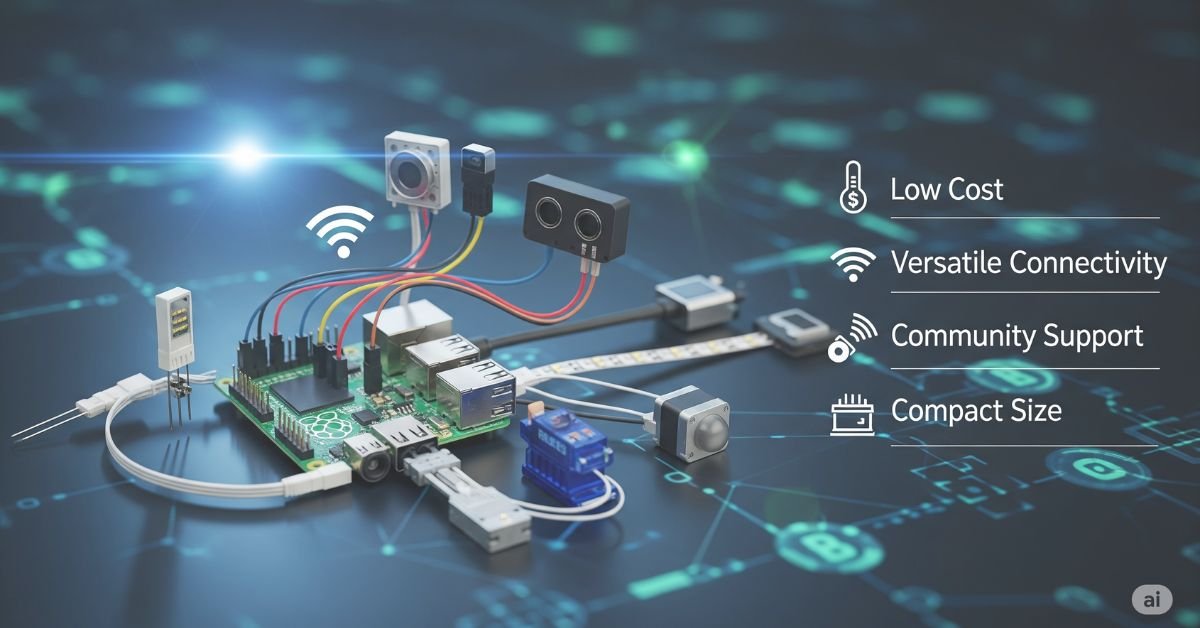The world is fast changing, and intelligent technology is at the forefront. There is one small device that is making a big impact—Raspberry Pi. You may wonder, “Why Is Raspberry Pi Used for IoT Devices?” Okay, the reason is easy. It’s affordable, compact, and capable. It assists individuals in connecting sensors, gathering data, and remotely controlling devices.
No expertise is required to use it. It’s beginner-friendly, yet smart enough for big companies. From farms to factories, people use it everywhere. In this guide, we’ll break down all the real reasons why Raspberry Pi is used for IoT devices, with examples and proof.
Raspberry Pi in Real-World IoT Projects
If you’re wondering Why Is Raspberry Pi Used for IoT Devices, look at real-life projects. People use it to build smart homes. You can turn on lights, lock doors, or control temperature with a Pi. Farmers use it to check soil moisture and manage water use. It helps save crops and money. In cities, it’s used to check air pollution and send live data to apps.
Even factories use it for automation. It watches machines, sends alerts, and helps with safety. These are not dreams. These are working projects using Raspberry Pi and simple code. That’s the power of Pi in the real world.
Read More About : How to Uninstall Node.js Completely (Windows, macOS, Linux)
Cheap Yet Powerful: The Real Value of Raspberry Pi
The cost of Raspberry Pi is low. You can buy a full computer for under $35. That makes it easy for schools, students, and small companies to start IoT projects. It’s also cheaper than many other boards used in the industry.
But cheap doesn’t mean weak. It has a real processor, memory, and storage. You can connect it to the internet and use it like any PC. You get great value without paying a lot. That’s one big reason why Raspberry Pi Used for IoT Devices in many places today.
Small Size That Fits Anywhere
Size matters in IoT. Devices need to fit in tight spaces. Raspberry Pi is tiny—many models are as small as a credit card. You can place it inside machines, on walls, or even in wearables.
Despite its size, it does powerful work. This mix of small size and big features makes it perfect for sensors and smart tools. Its size helps it blend in while still running a full Linux system. This is another key reason why Raspberry Pi Used for IoT Devices across many industries.
Enough Power to Handle Edge Computing
Raspberry Pi can process data locally. This is called edge computing. You don’t need to send everything to the cloud. It saves time and keeps data safe. You can run Python scripts or machine learning models right on the device.
This works well in places without fast internet. It also helps reduce network costs. So, Pi is not just collecting data; it’s smart enough to use it. That’s why tech teams love using it for IoT.
Built-In Connectivity Makes It Easy
Why Is Raspberry Pi Used for IoT Devices? One reason is the many ways it can connect. It has Wi-Fi, Bluetooth, and USB ports. Some models even have Ethernet for a stable connection. You don’t need to buy extra parts to connect it.
This built-in setup makes starting fast and easy. You can link it with other devices, cloud platforms, or mobile apps. Whether it’s a home project or an office setup, it gets online fast.
You will like : How to Uninstall Node.js on Mac (Complete Guide for Every Install Method)
GPIO Pins: The Key to Real-World Control
Raspberry Pi comes with GPIO pins. These let it talk to the outside world. You can connect sensors, lights, motors, and more. That’s what makes it perfect for IoT. It doesn’t just collect data—it interacts with the real world.
You can also use I2C, SPI, and UART protocols. These are important when working with many sensors or devices at once. These pins make the Pi feel like a bridge between code and hardware.
GPIO Pin Functions and Use Cases
| GPIO Feature | Description | Use Case |
| Digital I/O | Reads or sends signals | Control LEDs, read switches |
| PWM | Sends varying voltage | Motor speed control |
| I2C | Connects multiple devices | Weather sensors |
| SPI | Fast data transfer | LCD screens |
Open Source Software Means Total Freedom
Raspberry Pi runs on open-source systems. Most people use Raspberry Pi OS. But you can also use Ubuntu, Windows IoT Core, or custom builds. This gives developers control. You can change, test, and improve anything.
You’re not stuck with locked tools or licenses. It supports Python, JavaScript, and more. Plus, it works well with cloud platforms like AWS IoT or Azure. That’s real power in your hands. And that’s a huge reason why Raspberry Pi Used for IoT Devices everywhere.
Large Community Helps You Move Fast
If you get stuck, there’s always help. Raspberry Pi has a huge community. You’ll find forums, YouTube videos, GitHub codes, and tutorials. There’s help for every problem, from beginner to expert.
This cuts your learning time. You don’t need to figure everything out alone. You can copy ideas, reuse code, and ask questions. This support is priceless for new developers and startups.
Low Energy Use Saves Cost
Energy matters in IoT. Many projects use batteries or solar power. Raspberry Pi uses less energy than a PC. Models like the Pi Zero use just 0.5 watts. Even the newer Pi 5 is efficient.
You can add power-saving features too. Set the Pi to sleep, or shut off unused parts. This helps in remote places or mobile setups. That’s why it’s popular for smart farming, wildlife cameras, and weather tools.
Raspberry Pi Power Usage
| Pi Model | Power Use (Idle) | Power Use (Load) | Notes |
| Pi Zero | ~0.5W | ~1W | Best for battery projects |
| Pi 3 | ~2.5W | ~5W | Good for medium applications |
| Pi 4 | ~3W | ~7W | Needs cooling under load |
| Pi 5 | ~4W | ~8.5W | Great for powerful tasks |
Easy to Scale from One Device to Many
You can start with one Raspberry Pi. Later, you can add more as your project grows. You can clone SD cards, use Docker containers, or set up clusters. Scaling with Pi is simple and affordable.
This is perfect for companies building products. You test an idea, then grow. You don’t need to change hardware or rewrite your code. That’s a smart way to build real systems, fast.
Works with Cloud and IoT Platforms
Why Is Raspberry Pi Used for IoT Devices? Because it plays nice with the cloud. It connects with AWS, Google Cloud, and Azure. It supports MQTT, HTTP, and CoAP. That means it can send or receive data across the internet with ease.
This allows developers to build smart apps, dashboards, and controls. Pi can collect data, send it to the cloud, and react to changes. It’s the full package—data in, data out, and action.
Cloud Compatibility Overview
| Platform | Works with Pi? | Tools Used | Features |
| AWS IoT Core | Yes | MQTT, AWS SDK | Greengrass, device shadow |
| Azure IoT Hub | Yes | Azure CLI, Python SDK | Real-time data, auto updates |
| Google Cloud IoT | Yes | HTTP, MQTT, Device Manager | Cloud functions, storage |
Challenges Are Real, But Solvable
Every tool has limits. Raspberry Pi is not perfect. It’s not great for real-time systems. SD cards may wear out with too many writes. It can also get hot without cooling.
But solutions exist. You can use heatsinks, fans, and better power supply setups. You can also use external storage or watchdog timers. If you know the risks, you can handle them.
Better Than Many Other IoT Boards
Raspberry Pi is not the only board. But it offers more features in one place. Let’s compare with a few others.
Comparison Table: Raspberry Pi vs Other Boards
| Feature | Raspberry Pi | Arduino Uno | ESP32 | BeagleBone |
| OS Support | Yes | No | Limited | Yes |
| Wi-Fi/Bluetooth | Yes | No | Yes | Some Models |
| GPIO Pins | 26–40 | 14 | 34 | 65 |
| Price | Low | Very Low | Low | Medium |
| Community | Large | Large | Medium | Small |
FAQ”s
Can Raspberry Pi replace industrial IoT hardware?
It depends. Raspberry Pi works well in many cases, but for very high-speed or real-time jobs, industrial boards may be better.
Is Raspberry Pi safe for long-term IoT use?
Yes, but you should plan for heat control and data backup. Use good SD cards or external drives.
Which Pi model is best for IoT?
Pi Zero for small tasks, Pi 4 or Pi 5 for powerful jobs. Choose based on power and space.
Can I run IoT software on Raspberry Pi?
Yes, it supports Python, Node-RED, MQTT, and even Docker. It works with many cloud platforms too.
Do I need to know coding to use Pi for IoT?
Basic coding helps, especially in Python. But many tools like Node-RED make it easier without full coding.
Conclusion
Now you understand Why Raspberry Pi Used for IoT Devices in so many ways. It’s affordable, small, smart, and full of features. It fits both home and business needs. Whether you’re building one smart light or a full sensor network, Raspberry Pi is ready. That’s why it’s not just a hobby tool—it’s a serious player in the IoT world. Use it well, and it can power your next big idea.




